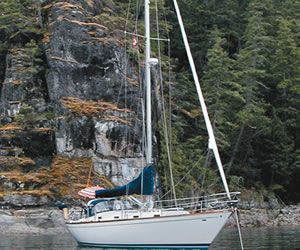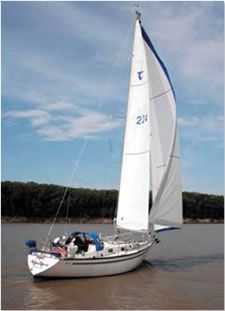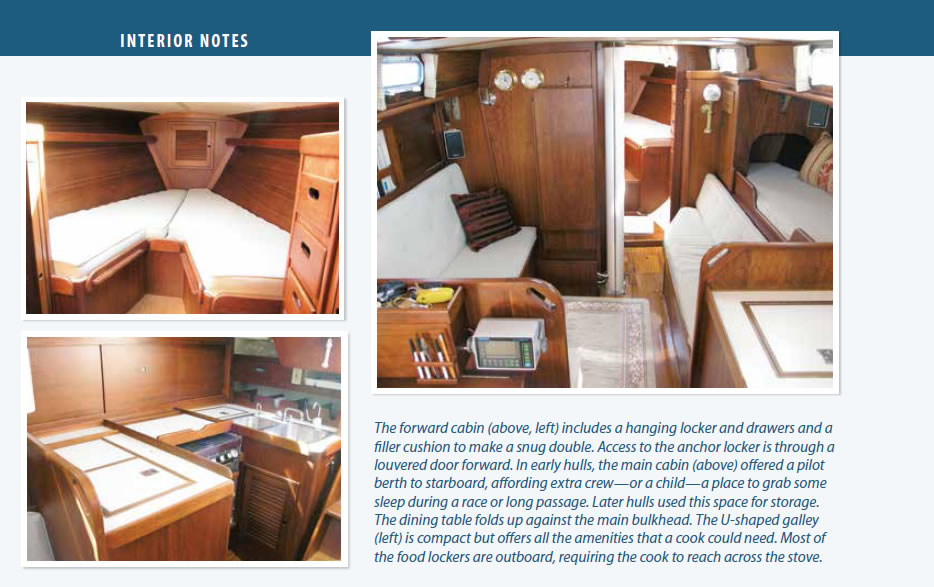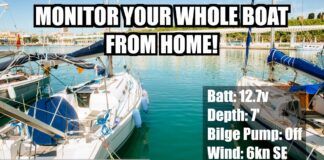
The Tartan 37 is a moderately high performance, shoal-draft cruiser built between 1967 and 1988 by Tartan Marine, a company that helped usher in the fiberglass era under Charlie Britton in the 1960s. At the time of the Tartan 37s introduction, the company had its headquarters in Grand River, Ohio, and a factory in Hamlet, N.C.
The company merged with troubled C&C in 1997 (and shed the brand in 2013), and like many builders, Tartan struggled financially after the dot-com bubble burst. In 2010, the company was pared down to just a handful of employees and was purchased by Steve Malbasa, who worked in the retirement investment field for 32 years. Malbasa has publicly expressed high aspirations for the Tartan, but it is unlikely to recapture the manufacturing success it had during the era of the Tartan 37. The Tartan 37 reviewed here is not to be confused with the Tim Jackett-designed 37-footers that followed.
Over the years, Tartan specialized in the production of well-finished boats geared toward the upper-income cruising sailor. Most of these early boats were Sparkman & Stephens (S&S) designs, and many were keel-centerboarders.
With their S&S designs and high-quality joinerwork, Tartans were regarded as a more affordable alternative to lines of boats such as the expensive Nautor Swans. By 1987, almost 500 Tartan 37s had been built, and the demand for the boat has continued to be strong. The longevity of the 37 in production is a remarkable testament to the inherent quality of both its design and its construction.
Until the early 1980s, most of the 37s were ordered with the original keel-centerboard configuration and only a few with a deep fin keel, often combined with a tall-rig favored by racers. In the 1980s, Tartan became a fan of the Scheel keel, a shoal-keel configuration designed by Henry Scheel that predated the era of winged keels. By enlarging the bottom of the keel with an end-plate, the Scheel keel helps to improve lift and to keep the weight of ballast low, in part at least overcoming two of the noted drawbacks of shoal keels. By 1985, the 37 was available with all three keel shapes. All of the designs offered good balance and favorable performance, but those wanting to eek out longer daily runs would gravitate toward the fin keel/tall-rig combination.
Tartan-built boats have been proven to have exceptionally good value over the years. On the used-boat market, they are among the most sought-after boats and have tended to maintain their owners equity. At the same time, new Tartans have never been cheap. Over the years the Tartan 37 was built, its base price almost doubled, reaching $100,000. Fully equipped, its price had risen to over $120,000 by 1987. Since then, prices on older boats have steadily declined, but today, even 30-year-old 37s are commanding over $50,000 as used boats.
Developed before builders strove to pack small apartments into the sterns of mid-sized cruisers, the Tartan 37 has attractive proportions. It has a gentle sheer and a straight raked stem profile, with moderate overhangs at both bow and stem. Underwater, the boat has a fairly long, low-aspect-ratio fin keel, and a high-aspect rudder faired into the hull with a substantial skeg. Freeboard is moderate. The boat is balanced and pleasant in appearance. It is not a character boat, but is attractive, fairly racy, and functional-a typical Sparkman & Stephens design of this era.
Construction
The Tartan 37 is a well-built boat for its time. Tartan made use of both unidirectional roving and balsa coring in stress areas. This yields a stiff, fairly light hull that is less likely to oil-can than the relatively thin solid layup used in many production boats. Some roving print-through-in which the fibers are visible through the gelcoat-is evident. There are also some visible hard spots on the outside of the hull.
Gelcoat quality is very good, but years of sun exposure and polishing might have taken their toll. Many of the older boats have been painted. The rudder is faired into the skeg with flaps to minimize turbulence. All through-hull fittings are recessed flush with the hull skin. For a cruising boat, remarkable attention was given to reducing skin friction and improving water flow.
Tartans construction was strong for the period, although as with any boat of this vintage, used 37s deserve close inspection. One area worth examining closely is the hull-to-deck joint, which is stiffened with an aluminum plate. This plate, which was glassed to the underside of the inward-flanged hull, was tapped to accept through bolts that bolted on the deck. The wide internal hull flange is bedded with butyl tape and polysulphide, the deck dropped on, and then bolted on with stainless-steel bolts which also hold on the teak toerail.
The aluminum plate (instead of multiple nuts and washers) expedited construction, but the combination of two dissimilar metals introduced the potential for galvanic corrosion, which could cause the bolts to strip out, or at the very least, loosen with pounding and flexing. Although this hull-deck joint is not known for failures, a prospective buyer should check it closely.
Weve noted that the toerail in many hulls is not well bedded. On the boat we tested, we were able to easily insert a thick knife blade under the toerail in several areas near the bow where the rail is subject to the most twist. Water will lie in this joint if it is at all open, making it difficult to keep varnish on the toerail.
Most deck hardware is backed with thick aluminum plates, which again raises the specter of galvanic corrosion. Closely check older boats for signs that water may have penetrated and caused the plates to swell or corrode. Pulpits are through-bolted with backing plates. The hull-to-deck joint is through-bolted across the transom, a good practice-uncommon for boats of this era, and even today. Interior construction finish is some of the best we have seen. Fillet bonding is exceptionally neat and clean. There are no raw fiberglass edges visible anywhere in the hull.
To keep the interior of the boat neat, the centerboard pennant comes up on deck through the center of the mast. This necessitates a complex mast step with transverse floors and a massive beam under the mast step to absorb compression, adding unnecessary complexity and making servicing the centerboard assembly more difficult and expensive than other, simpler arrangements.
Tartan uses bronze ball valves on through-hull fittings below the waterline. Exhaust line, cockpit scuppers, and bilge pump outlets are above the waterline, and have no shutoffs. The cockpit scuppers, which would be submerged while the boat is underway should have provision for shutoff.
Performance under sail
Owners report that the Tartan 37 is a well-mannered boat under sail. The boat will not perform at the grand-prix level, but it is no laggard, either. Several Tartan 37s have participated in the Marion/Newport-Bermuda race and regularly performed respectably. Although some early boats destined primarily for racers were purchased without roller furling headsails, nearly all the boats on the market today have furlers. Almost inevitably, there will be some sacrifice in windward performance with roller-furling headsails.
The optional inboard genoa track should be considered essential to those concerned with optimum windward performance. Coupled with the standard outboard track, this will allow versatility in sheeting angles. Headsail winches are within reach of the helmsman. This feature is vital for short-handed cruising and can help make the difference between a boat that is easy for two people to handle and one that is difficult. However, no real provision has been made for the installation of secondary headsail winches, should you wish to carry staysails. Small winches could be mounted on the cockpit coamings forward, but they could interfere with the installation of a dodger.
With good sails, the performance of the Tartan 37 will not be disappointing on any point of sail. Tartan brochures show the 37 happily romping along on a beam reach in a 15-knot breeze. We suspect that under those conditions, its owner is likely to be as happy as any sailor afloat.
Handling Under Power
The standard Universal 40 auxiliary diesel engine is more than adequate power for the Tartan 37. The tendency in many production boats today is toward smaller, lighter, lower-powered diesels, the opposite of the past American boatbuilding practice, which, like our automobiles, tended toward excessive horsepower.
The engine box of the Tartan 37 was only partially insulated, although many owners have since added their own insulation. You can easily access the front end of the engine by removing the companionway ladder.
On Deck
With wide decks, inboard chainplates, and a relatively narrow cabin trunk, fore and aft movement on the deck of the Tartan 37 is relatively easy. It would be easier if the lifeline stanchions had been positioned further outboard, rather than about three inches inboard of the toerail. There are bow chocks; and two well-mounted cleats forward. However, a line led through the chocks to the cleats bears against the bow pulpit. Shifting the cleats further inboard would provide a better lead.
Unlike most contemporary boats, there is no foredeck anchor well. This means that in order for an anchor to be readily available, it must be stowed in chocks on deck, or on an owner-installed bow roller. Then, you must face the problem of feeding the anchor rode below, more difficult for nylon rode than for chain. Molded foredeck anchor wells are becoming almost universal in modern boats, and while they make sense for the casual sailor, having one less deck hatch has its advantages on an oceangoing boat that may be burying its bow for days on end. In other words, not having an anchor locker accessible from the deck is not such a drawback as it may at first seem-particularly if long-range cruising is part of the plan.
There are strong, well-mounted teak grabrails on top of the cabin trunk that offer a handhold almost the full length of the cabin top. The molded cockpit coaming is a common Sparkman & Stephens feature and greatly facilitates the mounting of a dodger, almost standard equipment on any cruising boat.

The T-shaped cockpit of the Tartan 37 is comfortable for five adults while sailing. It has several unusual features. Rather than the usual unyielding fiberglass, there are teak duckboards on all cockpit seats. This means that you wont sit in a puddle when it rains, or when heavy spray comes aboard. These duckboards are comfortable, but they are held in place only by wooden cleats, with the exception of the starboard seat. A more secure arrangement should be provided for offshore sailing.
There is a teak-grated cockpit sump under the helmsmans feet. This shifts the cockpit drains inboard from the edge of the cockpit. The result is that a puddle can collect in the leeward corner of the cockpit when the boat is heeling in a blow with heavy spray coming aboard.
Access to the steering gear is via the lazarette hatch. There is good provision for an emergency tiller, but the lazarette hatch must be held open in some way to use the emergency steering. There is a drop-in shelf in the lazarette which allows using the locker with less risk of damage to the steering system, but we would be reluctant to store anything small there that might possibly jam in the steering gear.
With a low cabin trunk, visibility from the helm is excellent. Racing helmsman who plan to spend prolonged spells actively steering may provide a contoured seat, but in this era of auto-helming, a flat bench is just as functional. The relatively wide, flat top of the cockpit coaming provides reasonably comfortable seating for the helmsman who prefers to sit well to leeward or well to windward.
The main companionway is narrow and almost parallel-sided, features we like, but the bridgedeck is much lower than we prefer for offshore sailing. This low sill facilitates passage of the crew below. Unfortunately, it also makes it easier for water to get below should the cockpit flood. Coupled with the thin plywood dropboards, we feel this is a potential weakness in watertight integrity, and something that should be addressed in a boat that is intended for offshore work. Several companies today specialize in producing bullet-proof companionway arrangements that can be customized to fit almost any boat.
Belowdecks
Due to an abundance of teak and teak plywood, the interior of the Tartan 37 is dark and cave-like. This is much the same criticism we have made of other well-finished boats. Mind you, its a rather elegant cave, with excellent joinerwork throughout. Somehow, boat designers and builders have convinced most of the consuming public that teak is the only wood to use belowdecks. The fact is that there are many wonderful woods-ash and butternut, for example-that yield interiors that are lighter in both weight and color than teak.
The forward cabin of the Tartan 37 is truly comfortable for a boat of this size, with drawers, hanging lockers, separate access to the head, and enough room to dress in relative comfort. The completely louvered door separating the forward cabin from the main cabin looks nice, and does assist in ventilating the forward cabin. It limits privacy, however, and one good blow from a crew member caught off balance in a seaway would probably reduce it to a pile of teak kindling.
The head is quite comfortable, and it is possible to brace yourself adequately for use offshore. The shower drains into a separate sump, not into the bilge. The layout of the main cabin is conventional, with settee and pilot berth to starboard, dinette to port. The original design had a pilot berth to starboard necessitating a complex chainplate arrangement as well as a berth of dubious comfort and convenience.
By 1986, the pilot berth was eliminated in favor of shelves and gone, too, was the need for the can’tilevered chainplate support. While there is excellent storage space in the galley, one must reach across the stove to reach many of the cupboards, and its a long reach for a short person.
The stove is securely mounted and has a grab bar across its well to protect the cook, but this grab bar also inhibits the stoves gimballing function. There is no on-deck provision for storage for propane bottles, should you wish to use propane rather than the standard alcohol stove. There is room for CNG bottles to be stowed in the starboard cockpit locker, but CNG fill stations are few and far between in some areas.
The icebox appears to be well insulated on the sides, but why Tartan, like many other builders, failed to insulate and carefully fit the tops of their iceboxes totally escapes us. Although many contemporary builders have addressed this problem, we have found this shortcoming on a variety of boats, from the cheapest to the most expensive of this era.
The Tartan 37 has a large, well-designed navigation station. The quarterberth above it converts to a double berth. Ventilation is excellent, with eight opening ports and three hatches. There are also four vent/fans for the below-decks-two exhaust type and two low, plastic cowls in dorade boxes. We think four taller cowls in the dorades would be more effective, or better still, the five tall cowls shown in the original plans for the boat.
The vertical deckhouse bulkhead also allows a dropboard to be left out when it rains, further improving ventilation. Despite our complaints about the darkness of the interior, joinerwork is of excellent quality throughout. The finish work on the interior of the hull can complicate access to deck hardware, and certainly does not make it easy to survey the vessel.
In traditional wooden yacht construction, structural members are often left exposed for their intrinsic beauty, as well as for ventilation and preservation. In fiberglass boats, it is rather difficult to find intrinsic beauty in the structural material. Perhaps we are better off with it all hidden-as long as we know what holds the boat together. Given the Tartan 37s long reputation for solid construction, we certainly have confidence in what holds it together.
Conclusions
The Tartan 37, like other Tartan Marine boats of this era, is a well-built, well-mannered, fast cruising boat. The length of time it was in production and the number of 37s sold attests to the success of its concept; their value on the used boat market attests to the degree to which that concept has been realized. The boat is not immune to the problems that plague boats of this age. Prospective buyers should pay particularly close attention to the cored deck, which is prone to water damage and can be very expensive to repair.
Fortunately, the boat has attracted a wide following of enthusiasts who are willing to roll-up their sleeves and tackle these issues. The owners association provides detailed assistance in solving common problems, and the boats wide popularity there will likely always be a market for the 37, no matter how soft the sales of used boats become.
The 37 may never appreciate in the manner of some better finished (and more expensive) cruising boats such as Hinckleys that have practically become cult objects. Instead, the Tartan 37 is popular for justifiable reasons-performance, construction, and design. It is neither ostentatious nor plain. It is neither cheaply designed nor cheaply built.
Editors note: This review is an updated and expanded version of one previously published.








































I HOPE THAT I RETAIN A LITTLE OF ALL THAT I AM STUDYING?
.very interesting and the cabins intrigue me!